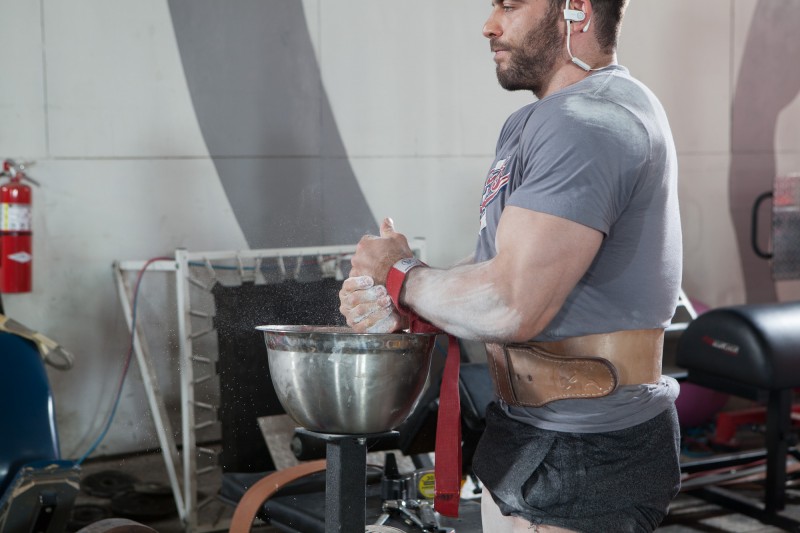
What is very clear to me is that in strength sports, the highest achievers are exceedingly capable of getting psyched up. They are sort of famous for it. I'm sure you have seen it, heard it, and in all probability lived it. There are lots of articles and tips on getting you revved up to perform. THIS ISN'T ONE OF THEM.
This article will deal with the other side of the coin—how to PSYCH DOWN, how to calm yourself back to a normal state of arousal that isn't burning energy at breakneck speed, and how to conserve all the energy between sets or attempts in competition. By conserving mental energy, you automatically benefit from conserving physical energy to use on subsequent efforts. You can rest on BOTH levels, not just your muscles.
If you haven't explored this facet of competitive sport, welcome to the Few. As far as I am concerned, NOBODY takes this seriously enough. That is if they consider it at all! There is a reason this is true. It's because, at the low and middle levels of extracting your potential, you have room to grow. Lots of it! Only unless you move from the intermediate stage and even surpass the advanced stage would you need it. You probably wouldn't stumble upon it by chance. It's my opinion that it makes itself known when you begin to run dry at the highest level of your ability. As you come closer to maximizing your potential, EVERYTHING MATTERS. And I mean that. Everything. Learning to conserve energy is a big part of everything.
RECENT: Why Do You Train With Weights?
Leaking Energy
Losing precious bits of energy from the beginning sets in a training routine will add up, and they just might cost you a rep (or two even!) at the end of the session. Those reps then have to WAIT until the next workout. By leaking out energy between sets and from poor technique in the exercise, you are retarding progress! If your early sets are sloppy, you might miss some reps in the later sets. If your mind gets fatigued from running full throttle not only prior to the set and during it, but even BETWEEN sets, you might get burned out before the last set is in the books. Every rep you miss has to wait until next time. Instead of moving up, you are marooned at your current strength level. You don't increase the weight if you are missing lifts. Yes, every single rep matters at the top. But it should matter to you now if you aspire to the top.
Perhaps the reason you're missing lifts is not that you lack the strength. Maybe it's because you run out of steam. You lack the energy. Maybe you run dry from WASTING ENERGY. Mental or physical makes little difference. In this article, I am going to deal with the mental steam and how to conserve it. You need to calm down between sets.
"Be at your best when the best is needed." That makes sense to me. When you need to be on fire, light up! But why burn in between the times of exertion? You don't need that flame raging when you are recovering. Save it all up for the bonfire! I have studied the great athletes from a wide (very wide) array of sports and physical feats. They all have this in common: They can turn it on and off like flipping a light switch! You can see it. It's in their eyes for certain, but if you are sensitive, you can feel it in their aura, whatever that is. But it is real, and it is powerful when it comes on. And the great ones know instinctively how to conserve it in the gaps. They flip the switch off just as well as they flip it on.
We laud intensity, especially in strength sports. So much so that plenty of people try to fake it. They want to impress you by letting you hear how hard they are working from across the gym. It is easy to get caught in the intensity trap. I know this because I know a guy. It seems like the thing to do in the gym. And I think that many people are afraid to lose momentum when they finally start hitting on all cylinders in a session. That is understandable. You had a bear of a time getting up for a hard session on a rough day, and you fear that if you back off, you could lose it. So, you just keep the pedal to the metal.
Calm Down
You have fallen under the spell of believing that you must exude "intensity" the whole time you are at the gym. I've even seen people who walk in and out of the place like they are involved in an altercation with themselves in their head! They stomp in mean and nasty. Not only is it my assertion that they are faking it by overplaying the role of a "hard-core" lifter, they are spending tons of mind energy without a weight or barbell in their hands! I call them the "Stompies."
That works… sort of...until you get a few years under your belt, and you get so strong that the loads get heavy! They demand more physically AND MENTALLY. You can't stomp away precious energy anymore.
You have been training and feeding your body the whole time. But what have you been doing for the mind? Therein lies the problem. The mental side dries up in that heat. Right when you need it most...at the end of a session. The mind and body are at differing levels of development. It rears it's ugly head at the high end when EVERYTHING MATTERS. You get away with it for quite a while until you start to scratch the peak of your ability. But why not learn it now? You'll need it later.
This is not purely esoteric. There is a real thing called motor unit (neuron) burnout. Firing the nerves over and over at a high level of demand temporarily wears them out. By learning to settle down and relax the brain when we don't need to be on the threshold of full-go power, we might delay that burnout AND perhaps hit a rep or two that we wouldn't have if we had not mastered calming the storm. Save the energy for when you need it. Make sure it is on hand when the going is at it's toughest.
I hope I have explained the value of putting in the time to learn to calm down. If I haven't, you'll encounter it again for yourself when you start to plateau as your power increases. If you don't come to it instinctively, I'm betting you'll reread this article. It makes training better and more productive at EVERY level of training. Efficiency is its own reward, but it is necessary at the top end. Again, why not learn it now? EVERY workout you have from then on will be more productive!

Listen to Music
One way to begin to embrace this is to use music. I had a Sony Walkman cassette player that I was constantly switching tapes in and out of. That was distracting. (Thank God for CDs which made it so easy to find a spot in a song!) Now your phone can handle all the hard stuff and you can program your soundtrack. It has never been so easy! By simply using uplifting, stimulating, motivational music before the lift, then switching to more soothing and calming music between sets, you give yourself a great head start. You don't want to put yourself to sleep, but you DO want to put yourself into a trance—sort of. A trance focused on the next attempt.
The goal is to focus your power and unleash it on the lift, then "stir the pot" in your belly for the next lift by putting things on "simmer." The focus between sets is to GATHER energy, NOT to use it up. The focus on a set is to let it all fly. FULL GO. It makes no sense to me that the same music is apropos for both tasks. In one instance, the energy is flowing out, and in the other, it should be flowing in. Find appropriate music styles to do the job to your taste. Switch from "go" to "slow" back and forth.
Try using different levels of intensity in your music for working through sets and in between sets. It will give you an idea of what I mean. I know not everyone is as emotionally impacted by music as I am. But I think most people are to some degree. It is not the crux of the technique, but it is a great intro. And it takes no real effort at all. That's the free one!
Sit Down
Another easy thing to do is to SIT DOWN. I see lots of people just frittering around in between sets. Here, there, back here...ugh. You just need two spaces. I espouse getting off the piece of equipment you are using (that is the work space) and move to another area (that is the rest space) to recover. When you get there, stay there! Sit down, and settle down.
I know this is a physical technique, but it will begin to trigger a mental response. Over here at the work space I have to be in high gear. Over there, in the rest space, I need to focus and calm down. When you move your body, the mind begins to anticipate what will happen, and it will start to soothe itself as you walk. When you walk back, it will start to gear up. Automatically!
Any real heavy training can almost be called violent. When the bar is loaded up, there is no room for lackadaisical attitudes. But you don't want to bring that violence back into the recovery area. Let it stay over with the iron. If you sit right on the bench you have just repped 405 on and have four more sets to go, do you want to stew in that rage and violence? I don't. I didn't. I got my ass out of the storm and ran for shelter. I provided that shelter by creating it, away from the work. That's where you want to rest. Once there, it was time to begin gathering the fortitude to run headlong into that hurricane another time. You muster energy and courage!
Set a recovery space and sit still in it.
INTERVIEW: 1035-Pound Bencher Jimmy Kolb
Now for some harder things. But even if you just do the above, you are conserving energy and will be more likely to hit more reps.
Mental Training
There is a very good reason that most people do not do much mental training if any at all. That is because it is so very, very hard. It is too understated to say that it is twice as hard as physical training. It is much harder than that. But let's just start there for a reference point. Imagine the toughest day of exercise that you've ever had in the gym and try to think about doing it again just as you finished the last rep of the last set. Now, do it TWICE! Imagine doing it all over again right then and there. Daunting if you have a good imagination. Right?
Well, real mental training is at least twice as hard as that! Twice as hard as twice as hard as ever! Maybe even moreso. I know because I have been busting my balls at it for decades, and it never got any easier! It is just like day one each morning. Although I am far from where I began, and the rewards get ever richer, I'm saying the effort it takes has not diminished. It might even be rougher. At least with working out, the weights get easier to lift!
But your mind is an endless opportunity to improve and go deeper. There is no easy day, no coasting, ever. There are no light days. There is no de-loading. Your mind can just go on forever. And it can take anything you can dish out. But the challenge is always the exact same. And it is very demanding.

To do well, you must distinguish between easy and simple. This technique is simple. I never said it was easy. It's hard as hell but almost too simple!
The real problem for me and many Western minds is that we get BORED. We get complacent with the UTTER SIMPLICITY involved with concentration. We crave excitement and stimulation. We want to be enticed, entertained, and engaged. We are attracted to complexity. It is natural to lean toward interesting things. Our minds gravitate to busy, shiny, multi-colored objects.
But to succeed in this, you have to move to less busyness and become fascinated by the singular, monochromatic, and basic. It goes directly against the cultural narrative we were sold from childhood. Your phone and television are just two easy examples. Good things are supposed to be hard to get and take lots of trying. They are to be complex and not directly at hand. That makes this seem too ordinary and, therefore, of lower value. Get over it!
By definition, focusing on ONE thing AUTOMATICALLY CANCELS OUT ALL OTHER THINGS! That leaves our Western mind feeling lonely. When we give it just a single thought or job to do, our multi-tasking belief system has a meltdown. It refuses in a manner of speaking because we have trained it to be that way. It constantly tries to add things in addition to the one point of focus we are attempting.
We grasp for MORE. Centering the mind and focusing requires that we abandon this plus-plus-plus attitude and hold only one thing in our consciousness. Are you feeling a tiny bit uncomfortable yet? You empty out until only ONE THING remains!
I'm saying that you must wrestle with the idea of letting go of things. You have to want LESS. At least for the moment. The kind of clarity I'm talking about can not penetrate your wall of internal dialogue and chatter—the whirlwind of thought. No wonder we have a hard time settling down. We have been training ourselves not to for our whole lives. It only prevails when things are quiet. Western minds prefer things noisy and full of excitement and energy.
If you dispute this meager explanation of how our Western mind works, then you will find the exercise I am advising to be next to impossible. You will run back to the comfort of chaos in your head the minute things get quiet. It will upset your applecart. You must accept the idea that your mind in its normal state (what you have come to accept as normal) is like a monkey on cocaine that has been stung by bees, whirling in a hurricane. If that's your baseline, and it feels regular to you, do not expect to feel at ease when you begin to learn to shut your mind down. You will not.
I can tell you this for a cold fact: You will begin to CRAVE the respite and serenity at some point down the line. It will begin to relax and rejuvenate you just as physical rest can. You just have to get off the hamster wheel for a moment now and again to see it.
Here is the caveat of what I'm about to explain. It is hard. It is weird. It is uncomfortable because it is NOT YOUR NORM and THAT PRECISELY is why so few ever explore it. Not because the world is lacking countless examples of how incredibly useful and wildly successful it is, but because they give up on it right at the very instant they begin, in spite of those examples. They find it "too simple" or say that it can not work because it is not complex enough. They ask how doing NOTHING can produce results.
So, if you are ready, let's go over a checklist before we begin. First, accept that your mind, when you think it is at peace, is a raging firestorm of activity—a monkey mind. You just can't feel it now. It is disguised as normal. You have to have faith that it can be light years quieter. CHECK.
Next, be prepared to feel weird. Empty to the point of drowning and grasping for something to keep you afloat. This happens to everybody to some degree or another. Try to go with it. Freak out, then return and try again. It gets better each trial. CHECK.
Embrace that the EFFORT. It is super hard to think LESS. You know how to buckle down and think MORE. But how exactly does a person THINK LESS? There, right there, is precisely where the hard, back-breaking (figuratively) WORK IS!

You have to FORCE IT, but to do so, you must ALLOW IT AND NOT FORCE IT! Paradox thy name is meditation! This is where the Western mind just makes a foolish judgment and says it is all nonsense. Mumbo-jumbo. Then the door gets slammed on it. We have to TRY without TRYING? We try not to try? Gibberish? Maybe in WORDS, IT IS, but when you DO IT, it makes sense. Doing is preferable to talking about doing. Try less. CHECK.
Breath Work
That said, let's give it a go. The accepted introduction to this is with breath work. It is a distraction technique that has been practiced and proven for literally centuries. Our goal is to quiet the mind so it can REST. If we try too hard to quiet down we end up WORKING OUR ASS OFF trying to rest! So the Masters have ingeniously found a way to fool your mind into calming by concentrating on your breath.
Here comes the SIMPLE PART that is so hard to believe. All you do is sit quietly (settle the body) and focus your attention on the air going into and out of your lungs—known as "watching" your breath. You mentally follow it in, then rest a brief moment, holding it still, and follow it out. Then rest for a slightly longer pause than after the inhalation. Over and over and over and over again. That's it. Nothing more.
After you become proficient in REMAINING ON TASK and seeing every breath go in, pause, and go out, you start to concentrate mostly on the space IN BETWEEN the in and out parts; the brief rest BETWEEN breaths where NOTHING AT ALL is happening. That is the crux of the biscuit—the rest in between breaths.
What you are doing is putting yourself in a state where you are DOING the absolute least you can do: Sitting still and just watching your breath. THEN you go for the gold and do even less. You ONLY EXIST in the moments BETWEEN breathing! You give up everything in your world except breathing, and once you get the hang of that, you give up breathing! You ONLY FOCUS ON THE SPACE BETWEEN BREATHING.
In this state, it's as close to zero as most of us can get where there is infinite room for anything to happen, even your hopes and dreams, no matter how extravagant they are. You live in the SPACE. Nothing is crowding you out, and there is room for anything. Nothing is in your way (the ultimate creative state).
The point is to stop doing anything and just be. To be and to not do. That is peace. How soothing would it feel if for just a little while you had NOTHING TO DO? No rules, requirements, responsibilities? All you had to do was to exist in the simplest way possible.
The technique culminates for beginners by spending longer and longer moments after the exhalation and before the next inhalation. As this time begins to broaden, the space you are lingering in opens up. It is the point where you can ALLOW the mind to be quiet. The longer this gets, the quieter you get. Breathe in, rest, breathe out, rest for a long time by delaying the next inhalation. Don't rush to the next part of the cycle. It happens when it happens, and it happens by itself. Stop TRYING to breathe. The rest between the end of the exhale and the start of a new breath is where you focus the longest. Snipers and competitive shooters are well versed in this breath control. They fire the shot in the space between exhale and inhale, or so I am told.
Summary
I am aware that you think that I have given you way too much information about this. While from my perspective, I feel that I have given you far too little. So in an attempt to oversimplify it for those just newly introduced to this, I'll summarize:
Marshaling your energy in a workout session is a balance between high-intensity set work and the low intensity recovery between those sets. If the expenditure is constantly at fever pitch, your highest mental state occurs at the beginning of the session and decays over time. But you need the highest concentration at the end of the workout when your body is tired, and the weights get to be their heaviest. To ameliorate this situation, we need to shift our mental state into a calming mode between the sets when we rest and don't need to stay psyched up. We need to save our mental energy for the lifts and spare ourselves the extra output. If we use it all up, we run dry at the end.
We need to learn to bounce back and forth from high to low. This means we must practice the calming part as it is definitely under-appreciated and not emphasized enough by coaches and sportsmen in general.
The method I espouse for beginners is to use differing intensities of music that stimulate before the lift and soothe after the lift. Also, setting aside a rest area that is away from the work area. By designating these spaces, the body moves the mind to a "place" where it knows it is going all out, or recovering and reassembling its strength. This way, there is no confusion, and it is easier to get to the mental state we want for each endeavor. The music and the movement become triggers just like Pavlov said.
Then at a minimum, one can focus on breathing for a minute or so to settle down between sets or attempts. Even 30 seconds of just watching the breath go in and out will be helpful. If a greater effect is desired, try to inhabit the spaces BETWEEN breaths.
To be certain, there's more to it, but this is a good foundation to attack the concept and see what it can do for you. It takes time and diligence. The "hard work" is continually returning to the practice and letting go more and more. The "work" is in doing less. I suppose the work is in concentration and discipline.
If you do something to try to calm yourself between sets, you are moving in the right direction. Maybe you won't be successful with everything I've outlined. Fine. Take what you CAN use. If I haven't given you enough, there are loads of good articles and books to fill your interest.
There isn't a kid in all of Asia taking any Martial Art or engaged in any competitive sport that isn't introduced to this at the very onset of their sporting career. They ALL get this. I've made my case for why it might be beneficial to learn. I've given you a cheap head start with some simple things you can do in TODAY'S training. I have given you nothing close to an education on the matter. But I hope that you see the value and pursue it further.
In all sincerity, two of the most hard-won secrets to my success, however modest it was, were learning and embracing the value of RECOVERY and MENTAL EXERCISES. Here is a mental exercise that can strengthen your mind at the same time you are strengthening your body. Don't be fooled by how simple or nonsensical it seems. Do it for 60 days and then throw it out if you like. Don't expect to notice anything before then. I said that this is SIMPLE...not FREE! You gotta pay the piper. If you can't put in two months to pursue your goals for the best chance of success, then, well, probably nothing I ever write appeals to you.
There are thousands upon thousands of things that can help you. I happen to believe that THIS ONE is at the top of the list. Learn to step away from the storm.










1 Comment